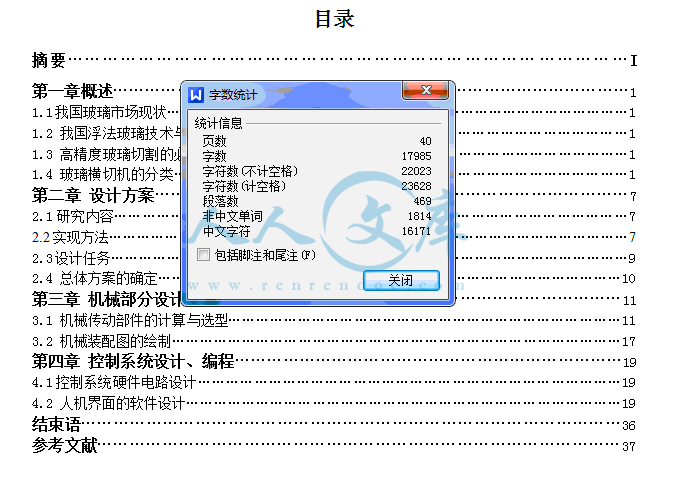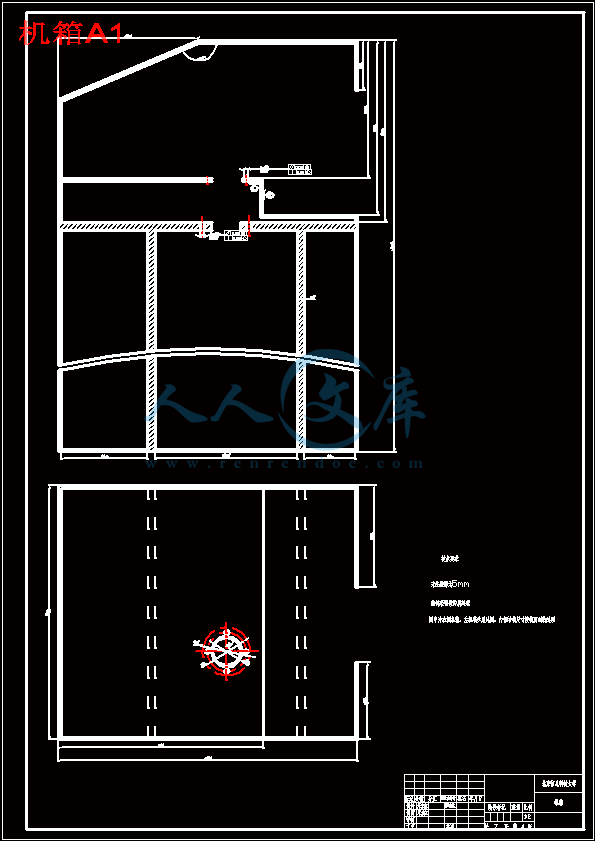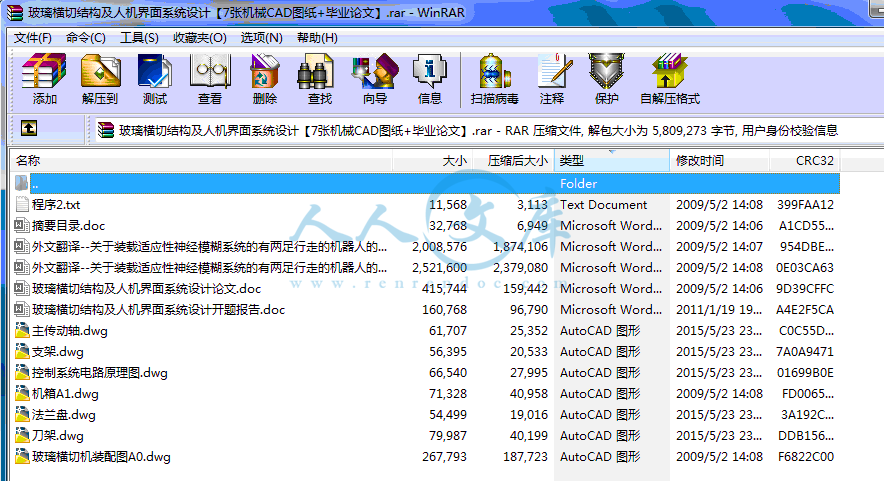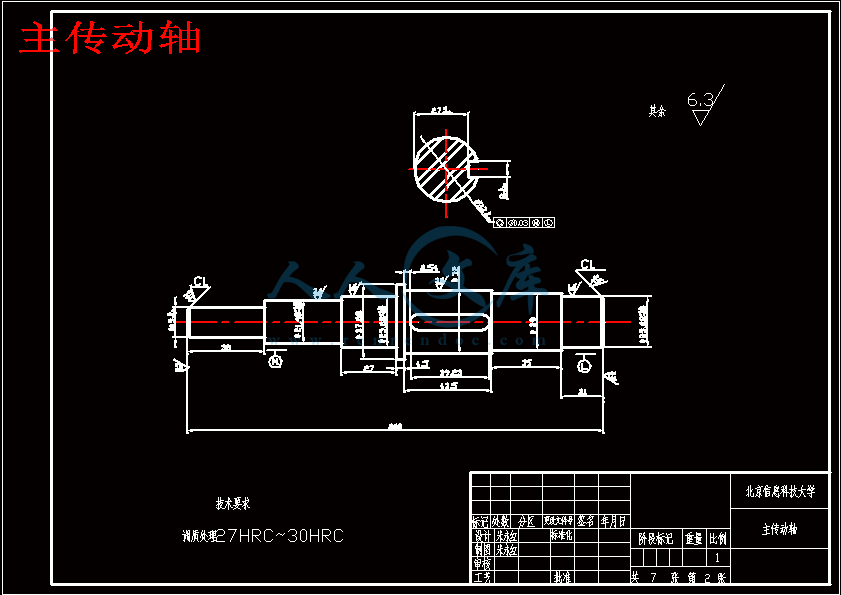玻璃横切结构及人机界面系统设计
40页 17000字数+说明书+外文翻译+开题报告+7张CAD图纸【详情如下】
主传动轴.dwg
刀架.dwg
外文翻译--关于装载适应性神经模糊系统的有两足行走的机器人的零刻点弹道造型 中文版.doc
外文翻译--关于装载适应性神经模糊系统的有两足行走的机器人的零刻点弹道造型 英文版.doc
控制系统电路原理图.dwg
摘要目录.doc
支架.dwg
机箱A1.dwg
法兰盘.dwg
玻璃横切机装配图A0.dwg
玻璃横切结构及人机界面系统设计开题报告.doc
玻璃横切结构及人机界面系统设计论文.doc
程序2.txt









摘要
本次毕业设计的题目是设计一种基于单片机控制的玻璃横切机。主要设计内容为:设计玻璃横切机的机械结构及人机界面系统。机械结构部分的设计确定为步进电动机带动的同步带传动系统。控制系统采用AT89C51为CPU。由矩阵键盘和RT12864M汉字图形点阵液晶显示模块组成人机界面系统。
首先,分析了玻璃横切机的市场前景及其在玻璃生产中的重要作用。然后,确定机械结构。根据现有的玻璃横切机的结构将其分类,并归纳出每一类玻璃横切机的机械机构特征、运行特征、切割原理等。本设计最终选用了其中的斜置、速度控制式的机械结构。基于这种机械结构,对步进电动机、同步带进行了选型和计算。绘制了机械结构装配图及部分零件图。
对于玻璃横切机的人机界面系统,本设计主要大致完成其程序的编写。即液晶显示四组控制参数,并可以通过键盘修改这些参数。本文中包括了各级程序流程图及其对应的说明。大致包括LCD驱动、键盘监控、液晶显示三个程序块。详见正文。
关键字 玻璃横切机; 步进电动机; 同步带; 单片机; 人机界面系统 ;液晶???????
This graduation project's topic is the design of one kind of the auto glass-cutter which controls based on the Microcontroller. The main content of the design is: the machine mechanism and man-machine contact surface system of the glass-cutter’s design .The mechanism part's design I determined it as that Pulse motor gives the power and the Transmission system transfer the power to the Ambulacrum.The control system uses AT89C51 as CPU. Forms the man-machine contact surface department of the matrix keyboard and the RT12864M Chinese character graph lattice liquid crystal display module.
First, has analyzed the glass-cutter’s market prospect and its influential role in the glass production. Then, determination of the machine mechanism. According to the existing glass-cutter’s structure I staple then to same types, and then concluded the mechanism character, sport character, cutting principle of each of the types. And so on.
This design finally has selected the tilts, speed control-like mechanism. Based on this kind of mechanism, I did the choice of the Pulse motor, ambulacrum’s and the count, checkout of them. I had drawn up the drawing of mechanism assembly and some part drawings.
Regarding the glass-cutter’s man-machine contact surface system, this design mainly completes its program’s compilation. Namely the liquid crystal display shows the four groups of controlled variables, and may revise these parameters through the keyboard. This article has included all levels of program flow diagram and the corresponding explanation. Includes the LCD actuation, the keyboard monitoring, and the liquid crystal display three blocks approximately. For details sees the main text.
Key-words glass-cutter ; Pulse motor ;ambulacrum ; Microcontroller ; man-machine contact surface system ; liquid crystal display module
目录
摘要(中文)…………………………………………………………………………………?
(英文)…………………………………………………………………………………П
第一章概述……………………………………………………………………………………1
1.1我国玻璃市场现状………………………………………………………………………………………1
1.2 我国浮法玻璃技术与国际先进水平的差距…………………………………………………………1
1.3 高精度玻璃切割的必要………………………………………………………………………………1
1.4 玻璃横切机的分类……………………………………………………………………………………1
第二章 设计方案……………………………………………………………………………7
2.1研究内容………………………………………………………………………………………………7
2.2实现方法…………………………………………………………………………………………………7
2.3设计任务…………………………………………………………………………………………………9
2.4 总体方案的确定………………………………………………………………………………………10
第三章 机械部分设计计算…………………………………………………………………11
3.1 机械传动部件的计算与选型…………………………………………………………………………11
3.2 机械装配图的绘制……………………………………………………………………………………17
第四章 控制系统设计、编程………………………………………………………………19
4.1控制系统硬件电路设计………………………………………………………………………………19
4.2 人机界面的软件设计…………………………………………………………………………………19
结束语………………………………………………………………………………………36
参考文献……………………………………………………………………………………37
横梁导轨安装在玻璃带输送辊道两边, 与玻璃带运动方向平行。切刀小车及其传动机构与导轨安装在横梁上, 横梁与玻璃带输送辊道 (玻璃带运动方向) 垂直放置。横梁在横梁传动机构的带动下做纵向往复运动, 切刀小车在其传动机构的带动下做横向往复运动。
垂直式横切机的基本工作原理是: 根据实际生产的工况与要求, 运动控制系统与机构分别对横梁和切刀小车传动机构进行控制, 使横梁前行运动速度V Z= V L ; 同时, 在电机转矩、转速及负载情况允许的条件下, 应尽可能提高切刀小车的工作速度V H , 以减少横切机整体的工作循环时间。
垂直式横切机的特点是控制方式简单易行, 但机械运动机构的组成方式较为复杂,并由于横梁的运动惯量较大, 因而不适用于玻璃带运动速度较高的生产场合。在实际生产中, 垂直式横切机在平拉或格法玻璃生产线上应用较多。
由于垂直式横切机的横梁速度应与玻璃带速度保持一致, 所以垂直式横切机又称为垂直随动式横切机。
1.4.2斜置式横切机
由玻璃带在线切割时所必须具有的横向运动和纵向运动可知, 切刀的实际工作运动, 应该是这两个相互垂直方向上运动的合成。反之, 若控制切刀进行该合成运动, 则可以对应地分解为横向与纵向运动。斜置式横切机, 就是通过把决定切刀小车运动方向的横梁与玻璃带输送辊道 (玻璃带运动方向) 倾斜放置, 并对切刀小车沿横梁的工作运动进行控制, 而实现玻璃带切割时所需的横向与纵向运动。
切刀小车的工作运动速度V Q 与横向运动速度V H 和纵向运动速度V Z 的关系, 可以由式 (1) 和式(2) 表示, 其中Α为V Q 与V H 之间的夹角。
V H= V Q·cosΑ (1)
V Z= V Q·sinΑ (2)
在玻璃切割过程中, 为了保证切痕的平直, 切刀的纵向运动必须与玻璃带的运动保持同步, 即必须保证V Z= V L。当V L 为恒量或基变量时, 由式(2) 可知, 可以通过分别控制Α和V Q 来实现V Z 与V L 相等的要求。若仅变化Α , 则称为角度调节方式;若仅变化V Q , 则称为速度控制方式。此外, 由于机械运动机构实现困难, 通常都不会采用对 Α和V Q同时调控的方式。
(1) 角度调节式横切机
采用角度调节方式的斜置式玻璃横切机, 称为角度调节式横切机。它的机械运动机构由横梁、切刀小车、小车导轨、小车传动机构和角度调节装置等所组成 (如图3 所示)。在角度调节时, 可令
V Z= V Q·sinΑ = V L (3)
则有
Α = arcsinV LV Q(4)
若保持V Q = 常量, 则角度Α与V L 之间的关系可由式 (4) 确定。
在实际生产中, 由于产品规格与实际工况的改变, 将会引起V L 的改变。因此, 需要根据实际确定的或实际测出的V L , 由式 (4) 中求出对应的Α值[Α ∈ (0, 90° ) ], 并据此调节横梁的实际斜置角度。第二章 设计方案
2.1、研究内容
研究方向、内容
随着单片机、PLC技术的发展,传统的控制系统逐渐被新型智能控制系统取代。鉴于PLC比单片机成本高,且输入/输出点数受到限制。本次毕业设计我主要研究单片机技术的全自动玻璃横切结构,分别对其机械结构和人机界面系统进行设计。
以下为欲设横切机的功能设定:
1)机械系统功能:
切割速度方向要求:玻璃带为运动的带状物体, 运动速度为V L。为了保证成品玻璃板为矩形, 横切机的切刀必须同时具有纵向与横向两个方向的运动 (如图1 所示)。纵向运动使切刀与玻璃带保持运动同步, 即纵向运动速度V Z 与玻璃带运动速度V L 保持一致; 而横向运动则使切刀完成切割工作, 其运动速度为V H。
刀架运动要求;接到单片机控制信号后,落刀,由同步带带动沿横梁方向切割玻璃,抬刀,返回原落刀点。其中落刀刀口压力要控制在指定厚度的玻璃的承载范围之内。要保证其对玻璃的冲击不至于使玻璃损坏。
横梁的直线度不低于对玻璃的直线度的要求。
2)人机界面系统功能:
手动输入所要切割的玻璃的长度,切片数量,落刀位置,抬刀位置等参数,并可以通过键盘修改相关参数。键盘设置急停键,抬刀键、回车键,以便切割出现问题时手动处理。
2.2、实现方法
2.2.1机械结构方案
对综述中提到的几种横切机的结构的比较本次毕业设计我也决定采用斜置式速度控制式机械结构。机械结构简图如图6.结束语
本文设计了一种玻璃横切机的机械结构及其人机界面系统。首先详细了解了各种玻璃横切机的机械结构,及其相应的切割特征。最终选择了斜置式速度控制式的机械结构。对传动系统的主要部件的同步带、步进电动机、轴承、主传动轴进行了选型、计算、校核。绘制了机械结构装配图、支架、刀架、机箱、法兰盘、主传动轴的零件图。进行控制系统设计,绘制了电路原理图。人机界面系统设计,其硬件由矩阵键盘、RT12864M ST7920 汉字图形点阵液晶显示模块组成。实现功能为:液晶显示切割玻璃长度、切片数量、落刀位置、抬刀位置四项参数,并可以通过键盘修改这些参数。做了软件设计、程序编写包括LCD驱动程序、键盘监控程序、显示程序三大模块。画出了软件流程图,包括总流程图及各个子程序流程图,并对程序进行了详细的说明。大致完成了任务书的要求。
由于技术、时间有限存在很多不足之处,望老师批评指导。
参考文献
1.尹志强.机电一体化系统设计课程设计指导书.机械工业出版社.2007.7
2.胡汉才.单片机原理及其接口技术.清华大学出版社.2004.2
3.纪名刚.机械设计.高等教育出版社.2001.6
4.银尧城.简明实用机械手册.机械工业出版社.1987.6
5.王建华.机械制图与计算机绘图.国防工业出版社.2004.9
6. 龚振邦,等 机器人机械设计【M】. 北京:电子工业出版社,1995
7. 殷际英编著 光机电一体化理论基础. 化学工业出版社
8. 薛万鹏等译 C程序设计教程. 机械工业出版社.
9. 聂刚. 平板玻璃横切机的分类及类别特征. 《玻璃》, 2002 年 第 2 期 总第161 期
10. 杨清翔 李文江.单片机在玻璃自动计数系统中的应用. 《辽宁工程技术大学学报 》2005年4月 第24卷增刊
11. 欧耀海.机电一体化全自动横切机. 《玻璃》 2007 年 第 6 期 总第 195 期
12. 刘克福 李晓虹。基于单片机技术的全自动横切机研制。 《微机算计信息》(嵌入式与SOC) 2008年 第24卷 第1-2期
13. 叶文才.自动玻璃切割机控制系统的设计
14. 张瑞 张宇干 谈军 费晓勇.浮法玻璃横切机智能控制系统的开发. 中国建材装备
15. 孟正大 郝立 戴先中. 开放式玻璃自动切割机计算机控制系统. 电气传动 2003 年 第 3 期
 川公网安备: 51019002004831号
川公网安备: 51019002004831号